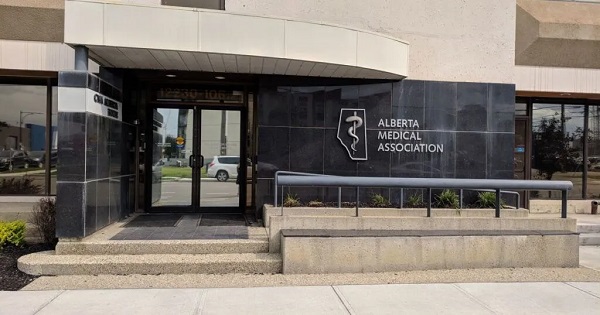Alberta
AMA challenged to debate Alberta COVID-19 Review

Justice Centre President sends an open letter to Dr. Shelley Duggan, President of the Alberta Medical Association
Dear Dr. Duggan,
I write in response to the AMA’s Statement regarding the Final Report of the Alberta Covid Pandemic Data Review Task Force. Although you did not sign your name to the AMA Statement, I assume that you approved of it, and that you agree with its contents.
I hereby request your response to my questions about your AMA Statement.
You assert that this Final Report “advances misinformation.” Can you provide me with one or two examples of this “misinformation”?
Why, specifically, do you see this Final Report as “anti–science and anti–evidence”? Can you provide an example or two?
Considering that you denounced the entire 269-page report as “anti–science and anti–evidence,” it should be very easy for you to choose from among dozens and dozens of examples.
You assert that the Final Report “speaks against the broadest, and most diligent, international scientific collaboration and consensus in history.”
As a medical doctor, you are no doubt aware of the “consensus” whereby medical authorities in Canada and around the world approved the use of thalidomide for pregnant women in the 1950s and 1960s, resulting in miscarriages and deformed babies. No doubt you are aware that for many centuries the “consensus” amongst scientists was that physicians need not wash their hands before delivering babies, resulting in high death rates among women after giving birth. This “international scientific consensus” was disrupted in the 1850s by a true scientist, Dr. Ignaz Semmelweis, who advocated for hand-washing.
As a medical doctor, you should know that science is not consensus, and that consensus is not science.
It is unfortunate that your AMA Statement appeals to consensus rather than to science. In fact, your AMA Statement is devoid of science, and appeals to nothing other than consensus. A scientific Statement from the AMA would challenge specific assertions in the Final Report, point to inadequate evidence, debunk flawed methodologies, and expose incorrect conclusions. Your Statement does none of the foregoing.
You assert that “science and evidence brought us through [Covid] and saved millions of lives.” Considering your use of the word “millions,” I assume this statement refers to the lockdowns and vaccine mandates imposed by governments and medical establishments around the world, and not the response of the Alberta government alone.
What evidence do you rely on for your assertion that lockdowns saved lives? You are no doubt aware that lockdowns did not stop Covid from spreading to every city, town, village and hamlet, and that lockdowns did not stop Covid from spreading into nursing homes (long-term care facilities) where Covid claimed about 80% of its victims. How, then, did lockdowns save lives? If your assertion about “saving millions of lives” is true, it should be very easy for you to explain how lockdowns saved lives, rather than merely asserting that they did.
Seeing as you are confident that the governments’ response to Covid saved “millions” of lives, have you balanced that vague number against the number of people who died as a result of lockdowns? Have you studied or even considered what harms lockdowns inflicted on people?
If you are confident that lockdowns did more good than harm, on what is your confidence based? Can you provide data to support your position?
As a medical doctor, you are no doubt aware that the mRNA vaccine, introduced and then made mandatory in 2021, did not stop the transmission of Covid. Nor did the mRNA vaccine prevent people from getting sick with Covid, or dying from Covid. Why would it not have sufficed in 2021 to let each individual make her or his own choice about getting injected with the mRNA vaccine? Do you still believe today that mandatory vaccination policies had an actual scientific basis? If yes, what was that basis?
You assert that the Final Report “sows distrust” and “criticizes proven preventive public health measures while advancing fringe approaches.”
When the AMA Statement mentions “proven preventive public health measures,” I assume you are referring to lockdowns. If my assumption is correct, can you explain when, where and how lockdowns were “proven” to be effective, prior to 2020? Or would you agree with me that locking down billions of healthy people across the globe in 2020 was a brand new experiment, never tried before in human history? If it was a brand new experiment, how could it have been previously “proven” effective prior to 2020? Alternatively, if you are asserting that lockdowns and vaccine passports were “proven” effective in the years 2020-2022, what is your evidentiary basis for that assertion?
Your reference to “fringe approaches” is particularly troubling, because it suggests that the majority must be right just because it’s the majority, which is the antithesis of science.
Remember that the first doctors to advocate against the use of thalidomide by pregnant women, along with Dr. Ignaz Semmelweis advocating for hand-washing, were also viewed as “advancing fringe approaches” by those in authority. It would not be difficult to provide dozens, and likely hundreds, of other examples showing that true science is a process of open-minded discovery and honest debate, not a process of dismissing as “fringe” the individuals who challenge the reigning “consensus.”
The AMA Statement asserts that the Final Report “makes recommendations for the future that have real potential to cause harm.” Specifically, which of the Final Report’s recommendations have a real potential to cause harm? Can you provide even one example of such a recommendation, and explain the nature of the harm you have in mind?
The AMA Statement asserts that “many colleagues and experts have commented eloquently on the deficiencies and biases [the Final Report] presents.” Could you provide some examples of these eloquent comments? Did any of your colleagues and “experts” point to specific deficiencies in the Final Report, or provide specific examples of bias? Or were these “eloquent” comments limited to innuendo and generalized assertions like those contained in the AMA Statement?
In closing, I invite you to a public, livestreamed debate on the merits of Alberta’s lockdowns and vaccine passports. I would argue for the following: “Be it resolved that lockdowns and vaccine passports imposed on Albertans from 2020 to 2022 did more harm than good,” and you would argue against this resolution.
Seeing as you are a medical doctor who has a much greater knowledge and a much deeper understanding of these issues than I do, I’m sure you will have an easy time defending the Alberta government’s response to Covid.
If you are not available, I would be happy to debate one of your colleagues, or any AMA member.
I request your answers to the questions I have asked of you in this letter.
Further, please let me know if you are willing to debate publicly the merits of lockdowns and vaccine passports, or if one of your colleagues is available to do so.
Yours sincerely,

John Carpay, B.A., LL.B.
President
Justice Centre for Constitutional Freedoms
Alberta
Made in Alberta! Province makes it easier to support local products with Buy Local program

Show your Alberta side. Buy Local. |
When the going gets tough, Albertans stick together. That’s why Alberta’s government is launching a new campaign to benefit hard-working Albertans.
Global uncertainty is threatening the livelihoods of hard-working Alberta farmers, ranchers, processors and their families. The ‘Buy Local’ campaign, recently launched by Alberta’s government, encourages consumers to eat, drink and buy local to show our unified support for the province’s agriculture and food industry.
The government’s ‘Buy Local’ campaign encourages consumers to buy products from Alberta’s hard-working farmers, ranchers and food processors that produce safe, nutritious food for Albertans, Canadians and the world.
“It’s time to let these hard-working Albertans know we have their back. Now, more than ever, we need to shop local and buy made-in-Alberta products. The next time you are grocery shopping or go out for dinner or a drink with your friends or family, support local to demonstrate your Alberta pride. We are pleased tariffs don’t impact the ag industry right now and will keep advocating for our ag industry.”
Alberta’s government supports consumer choice. We are providing tools to help folks easily identify Alberta- and Canadian-made foods and products. Choosing local products keeps Albertans’ hard-earned dollars in our province. Whether it is farm-fresh vegetables, potatoes, honey, craft beer, frozen food or our world-renowned beef, Alberta has an abundance of fresh foods produced right on our doorstep.
Quick facts
- This summer, Albertans can support local at more than 150 farmers’ markets across the province and meet the folks who make, bake and grow our food.
- In March 2023, the Alberta government launched the ‘Made in Alberta’ voluntary food and beverage labelling program to support local agriculture and food sectors.
- Through direct connections with processors, the program has created the momentum to continue expanding consumer awareness about the ‘Made in Alberta’ label to help shoppers quickly identify foods and beverages produced in our province.
- Made in Alberta product catalogue website
Related information
Alberta
Province to expand services provided by Alberta Sheriffs: New policing option for municipalities

Expanding municipal police service options |
Proposed amendments would help ensure Alberta’s evolving public safety needs are met while also giving municipalities more options for local policing.
As first announced with the introduction of the Public Safety Statutes Amendment Act, 2024, Alberta’s government is considering creating a new independent agency police service to assume the police-like duties currently performed by Alberta Sheriffs. If passed, Bill 49 would lay additional groundwork for the new police service.
Proposed amendments to the Police Act recognize the unique challenges faced by different communities and seek to empower local governments to adopt strategies that effectively respond to their specific safety concerns, enhancing overall public safety across the province.
If passed, Bill 49 would specify that the new agency would be a Crown corporation with an independent board of directors to oversee its day-to-day operations. The new agency would be operationally independent from the government, consistent with all police services in Alberta. Unlike the Alberta Sheriffs, officers in the new police service would be directly employed by the police service rather than by the government.
“With this bill, we are taking the necessary steps to address the unique public safety concerns in communities across Alberta. As we work towards creating an independent agency police service, we are providing an essential component of Alberta’s police framework for years to come. Our aim is for the new agency is to ensure that Albertans are safe in their communities and receive the best possible service when they need it most.”
Additional amendments would allow municipalities to select the new agency as their local police service once it becomes fully operational and the necessary standards, capacity and frameworks are in place. Alberta’s government is committed to ensuring the new agency works collaboratively with all police services to meet the province’s evolving public safety needs and improve law enforcement response times, particularly in rural communities. While the RCMP would remain the official provincial police service, municipalities would have a new option for their local policing needs.
Once established, the agency would strengthen Alberta’s existing policing model and complement the province’s current police services, which include the RCMP, Indigenous police services and municipal police. It would help fill gaps and ensure law enforcement resources are deployed efficiently across the province.
Related information
-

 2025 Federal Election2 days ago
2025 Federal Election2 days agoOttawa Confirms China interfering with 2025 federal election: Beijing Seeks to Block Joe Tay’s Election
-

 2025 Federal Election1 day ago
2025 Federal Election1 day agoBREAKING: THE FEDERAL BRIEF THAT SHOULD SINK CARNEY
-

 2025 Federal Election2 days ago
2025 Federal Election2 days agoHow Canada’s Mainstream Media Lost the Public Trust
-

 2025 Federal Election2 days ago
2025 Federal Election2 days agoReal Homes vs. Modular Shoeboxes: The Housing Battle Between Poilievre and Carney
-

 Media1 day ago
Media1 day agoCBC retracts false claims about residential schools after accusing Rebel News of ‘misinformation’
-

 John Stossel1 day ago
John Stossel1 day agoClimate Change Myths Part 2: Wildfires, Drought, Rising Sea Level, and Coral Reefs
-

 2025 Federal Election1 day ago
2025 Federal Election1 day agoCHINESE ELECTION THREAT WARNING: Conservative Candidate Joe Tay Paused Public Campaign
-

 Business1 day ago
Business1 day ago‘Great Reset’ champion Klaus Schwab resigns from WEF


